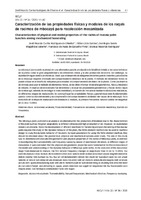Caracterización de las propiedades físicas y modales de los raquis de racimos de mbocayá para recolección mecanizada
Characterization of physical and modal properties of the rachis of macaw palm bunches aiming mechanized harvesting

Date
2020-11-27Author
Cunha Rodrigues de Oliveira, Zenil Ricardo
Santos, Fábio Lúcio
Valente, Domingos Sarvio Magalhães
Assis de Carvalho Pinto, Francisco de
Resende Rodrigues, Mateus
Metadata
Show full item recordAbstract
La mbocayá (Acrocomia aculeata) es una alternativa para la producción de biodiésel debido a las características de la planta como la gran adaptabilidad a los diferentes climas y la alta producción de aceite. Sin embargo, su explotación sigue siendo un obstáculo. Dado que el desarrollo de máquinas eficientes para la cosecha y poscosecha de la mbocayá requiere el estudio del comportamiento dinámico de la planta. El método de elementos finitos se puede utilizar en el diseño de máquinas para estudiar el comportamiento dinámico de la planta. Como parámetros de entrada para usar el método de elementos finitos, se les debe informar el sistema geométrico, físico y mecánico en estudio. El objetivo de este estudio fue determinar y evaluar las propiedades geométricas y físicas de los raquis de la mbocayá, además de investigar la transmisibilidad y el barrido de frecuencia mediante vibraciones mecánicas, en diferentes etapas de maduración. Se concluyó que las propiedades físicas y geométricas eran fundamentales para la construcción del modelo y la comprensión del comportamiento dinámico del raquis de la mbocayá. En la evolución de la etapa de maduración de inmaduro a maduro, la primera frecuencia natural cambia en magnitud de 22.66 a 15.90Hz. The Mbocaya palm (Acrocomia aculeata) is an alternative for the production of biodiesel due to the characteristics of the plant such as the great adaptability to different climates and high production of oil. However, its exploitation remains an obstacle. Since the development of efficient machines for harvesting and post-harvesting of the macaw palm requires the study of the dynamic behavior of the plant, the finite element method can be used in machine design to study the dynamic behavior of the plant. As input parameters for using the finite element method, they should be informed about the geometrical, physical and mechanical system under study. The aim of this study was to determine and evaluate the geometric and physical properties of the rachis of Mbocaya palm, in addition to investigating the transmissibility and frequency sweep by means of mechanical vibrations, at different stages of maturation. It was concluded that the physical and geometric properties were fundamental for the construction of the model and understanding of the dynamic behavior of Mbocaya palm rachis. In the evolution of the maturation stage from immature to mature, the first natural frequency changes in magnitude from 22.66 to 15.90Hz. Dui exercilis dipsusci el ea faciduis dions dolorero dion exer sum ex endit aciduis accumsan ulpute magnim doloreros dolore commy nim numsan eu feu feui tat vel dolumsandre dolore faci etum ver suscidunt aute tio con ullum velestio et lam et lum doluptat wis nissequis nons nos enim velit ad minisim adionulla ate magnis delit ectetum accum zzrit, quam dionullam ing eum velit ute te miniscil utpat lor sum dolore ming ex etummy nim ecte min henit do con volore facipit, vero dolorting et, quam, venim doloreros nos augait lor sequiscinci bla feu feui esendre core magnis adiat, con hendigna commodolent wisci elit eugait.
URI
https://hdl.handle.net/20.500.12219/2842https://doi.org/10.36995/j.recyt.2020.34.007
https://www.fceqyn.unam.edu.ar/recyt/index.php/recyt/article/view/656
Collections
The following license files are associated with this item:



